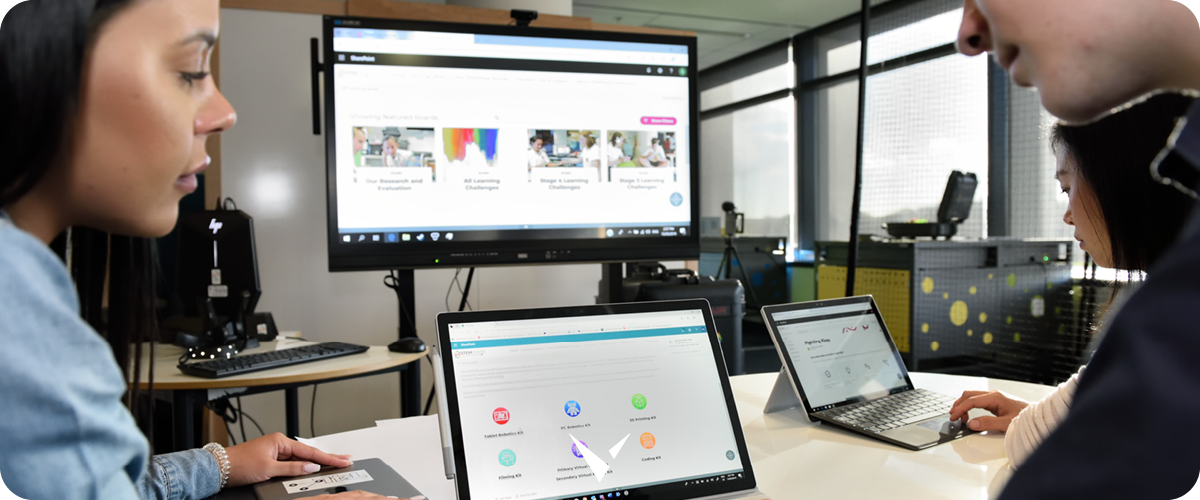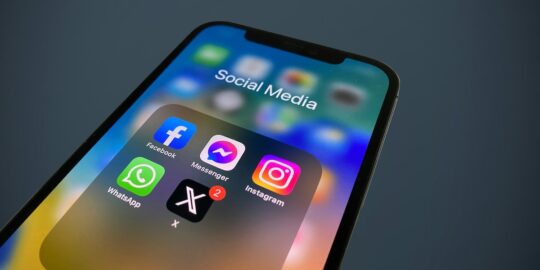
After a nearly two-year hiatus resulting from the COVID 19 pandemic, students are settling back into a normal classroom routine. Now is the time to revitalize their social relationships through collaborative learning, an approach to education that focuses on group learning tasks as opposed to individual instruction.
Collaborative learning allows students to build relationships while pursuing common goals such as problem-solving, understanding concepts, or completing a project. This approach to learning is critical in our increasingly globalized and technological world. To facilitate collaborative learning, EdTech developers continue to create several collaborative technology tools for students.
These tools can be paired with screen mirroring technology in the classroom to increase their effectiveness and capitalize on the collaborative learning experience. In this blog, we’ll look at some collaborative technology tools that can be used in and outside of classrooms for better learning opportunities.
What Are the Benefits of Collaborative Technology Tools for Students?
Are two heads better than one? The growing body of empirical research on collaborative learning says yes!
Collaborative learning develops critical thinking skills, improves academic performance, involves students in every step of the learning process, facilitates interpersonal relationships, and builds diversity awareness and understanding. This approach also helps students improve their self-esteem while lowering anxiety.
Given the many benefits of collaborative learning, it’s no wonder collaborative technology for students is expanding at an astonishing rate, including tools and systems designed to facilitate collaborative learning both inside and outside the classroom.
Collaborative technology tools for students include gamification tools, blogging tools, tools that encourage cross-cultural communication, collaborative whiteboard tools, collaborative annotation tools, and even classroom tools like wireless screen mirroring that can bring all this technology to the classroom display.
Fortunately, there is plenty of empirical evidence supporting the use of innovative technologies that facilitate collaborative learning. So, let’s explore some of the different types of collaborative technology tools for students that foster interpersonal skills and academic excellence in students.
Related: Recognizing the Power of Collaboration as the Essential Tool for Educators
Video Conferencing
Video conferencing enables users to hold face-to-face meetings without any location constraints. The scope of collaboration is broadened beyond the confines of the classroom to include interactions across the globe.
Distance learners are better supported in remote learning, but, more than that, video conferencing allows those who otherwise wouldn’t be able to contribute to a physical classroom the ability to do so.
For example, students in the physical classroom can participate in a show-and-tell with family members from different geographical locations who use video conferencing to connect with a student device in the classroom. Integrated with technology like screen mirroring, the teacher can display each student’s device to a main display for the class to see, encouraging interaction and community learning in a variety of ways.
Gamification
Gamification in education refers to the incorporation of gameplay elements, such as scorekeeping, competition, rules of play, and rewards, into the learning process. Gamification can be an effective learning strategy.
A 2020 meta-analysis shows that the gamification of learning, particularly in the context of collaboration, enhances students’ ability to think, motivate themselves and behave in a way that’s conducive to learning. It also makes learning a lot more fun too!
With collaborative technology tools for students, the options for learning gamification are almost limitless. Students can be present in an online community with a customizable avatar that imitates their unique personalities and styles. Educational lessons can be simulated in virtual or augmented reality, and digital rewards can foster healthy competition. Teachers can also gamify the assessment process, which may be less intimidating and stressful for learners.
Additionally, teachers can pair gamification with screen mirroring and allow students to send images from their device screen to the classroom display to show their “game” progress, present their avatar, and work together, transforming the mundane classroom into a full-fledged learning adventure.
Minecraft: Education Edition is a game-based learning tool that invites learners to collaborate on coursework in the massive and customizable world of Minecraft. This platform offers teachers the opportunity to enroll in the Minecraft Teachers Academy and become Minecraft-certified teachers.
Breakout EDU is a game library that teaches students critical thinking, collaboration, creativity, and communication across various academic disciplines. It also provides games that foster social-emotional learning, such as self-awareness, self-control, and interpersonal skills.
Word Processing and File Sharing Software
File sharing software, such as Google Docs and Dropbox, enables teachers and students to store and share digital files by uploading them to online cloud storage or directly over the internet. File sharing has several benefits in the context of education.
File sharing in the form of online document creation and editing also helps students connect to share ideas, study for tests, and help each other out. Sharing a Google Doc between students, for example, allows them to collaborate directly on a project before presenting it to the rest of the class.
Paired with screen mirroring, these are simple but effective collaborative technology tools for students who are working on projects together and want to bring their work to the whole class. The teacher can send each group’s project to the classroom display, on-demand, and invite feedback or other interactions, such as annotations.
Online Whiteboards
Teachers can make online or classroom learning more interactive and engaging by using online whiteboards. Online whiteboards are spaces where students and teachers can write, draw and visualize concepts in real-time on a shared canvas.
Unlike traditional or digital whiteboards, online whiteboards can be accessed on nearly any device, including laptops, mobile phones, and tablets. Teachers and students can collaborate on an online whiteboard through these devices with a cheap stylus.
Users can attach images, links, and other files onto the online whiteboard with ease and optimal accessibility. Other features of online whiteboards are audio and video options, curated educational content, and an unlimited canvas for large and complex lessons.
These whiteboards can then be shared to the main classroom display, using screen mirroring technology, for easy viewing and collaborative discussion.
MURAL is a multifaceted online digital canvas or whiteboard that serves as a collaborative space for innovation, problem-solving, and design in the context of education. MURAL offers over 300 templates to help users visualize, organize and share information in class or remotely.
Collaborative Annotation
Students and teachers no longer need to destroy new and expensive physical textbooks with highlights, dogears, and margin comments. Collaborative annotation tools allow users to mark up their digital course material to keep track of their progress and annotations.
Moreover, collaborative annotation enables users to share their bookmarks and annotations with teachers and peers, thus facilitating active engagement and collaboration in the classroom.
Collaborative annotation is not limited to digital texts. Teachers can also annotate video content from YouTube or other video-sharing platforms. Gone are the days when teachers had to hit pause on a DVD to write comments about the digital content on a physical whiteboard.
Paired with screen mirroring, any student can present their own work to the class via the main classroom display and annotate as they go, integrating whatever collaboration the teacher chooses for the project.
VideoAnt is an online annotation tool for adding annotations, content, and bookmarks to web-hosted videos. Its name is quite clever. ‘Ant’ is short for ‘annotation,’ and a video annotated with VideoAnt software is called an ‘Ant.’ Users have access to their own customizable ‘Ant Farm,’ where they can create, manage, and share their annotated videos.
Hypothesis is a collaborative annotation tool that enables users to take notes on content across the web, including classroom reading materials, the news, blogs, books, and academic articles. Hypothesis celebrates reading as an “active, visible and social” endeavor.
Digital Memorization Tools
Rote learning may seem like a redundant exercise in a digital age when information is accessible at our fingertips. However, research shows that rote learning changes the brain’s structure and helps students recall more information over time.
To facilitate and assess rote memorization, students would use physical flashcards and be given frequent in-class quizzes. However, creating flashcards is tedious, and developing quizzes was often a burden left for teachers.
Fortunately, several digital memorization tools are available to make memorization a more collaborative process. For instance, students and teachers can create digital flashcards to promote memory recall, quiz each other, and participate in the process of quiz creation.
Paired with screen mirroring technology, any student with a device can be permitted to display the specific digital flashcards they are working on for the whole class, encouraging collaborative practice.
Quizlet is a company that develops an array of digital learning tools, such as flashcards, matching games, electronic assessments, and live quizzes. Quizlet also lets users listen to study materials using text-to-speech software. Quizlet also provides access to an impressive database of user-created flashcards.
Flashcard Hero is another flashcard app that supports space repetition memorization, a technique that improves information retention and recall. Challenging flashcards are exposed to the user more frequently than easier flashcards. This allows users to track their progress and know when the information is stored in their memory.
Related: The Purpose of Technology in the Classroom
Cross-Cultural Communication Tools
In an increasingly globalized world, students are being exposed to different cultural traditions, worldviews, and value systems. Cross-cultural communication tools can help both teachers and students foster respect for diverse perspectives and remove barriers to cross-cultural communication.
Moreover, these tools can leverage the skills and knowledge of people across various cultures to promote critical thinking, solve problems, and achieve shared goals.
PenPal Schools is a learning platform that fosters academic skills within a global learning community of classrooms across over 150 countries. This platform is a great resource for teachers who not only focus on universally relatable skills like math and geography but also sociocultural and global citizenship skills.
ePals is another learning platform that offers a collaborative global classroom for students to safely communicate and learn from each other. Teachers can customize their own classrooms and invite learners from across the world to engage in a shared project.
Just as in video conferencing, pairing this communication with screen mirroring allows students to share their pals with the entire class, making the experience a collaborative one and allowing students to share what they’re learning about different communities and cultures.
Toward a Collaborative Tech Classroom
The lockdowns resulting from the COVID 19 pandemic may have interrupted the social and academic development of many students. Yet, the adverse effects of social distancing and peer isolation may have been buffered by advances in collaborative technology tools for students.
If anything, the pandemic solidified the notion of a technology-rich classroom as a viable education solution in the collective mind of educators and students alike.
With the availability of screen mirroring technology, we are one step closer to digitalized collaborative classrooms. Gone are the days of tangled or faulty VGA cords and HDMI cables.
They’ve been replaced by wireless solutions that make teachers more productive and students more engaged. Teachers can wirelessly mirror the screen of any device to any display. This enables students to collaborate with other students on any kind of app or classroom presentation.
All of the tools we’ve discussed are made better, more active, and more productive by the use of wireless screen mirroring to increase collaborative possibilities. With this tool, the teacher maintains complete control of every device’s wireless screen mirroring ability while being able to move freely throughout the classroom.
Start Using Collaborative Technology Tools in Your Classroom Today
In an increasingly globalized and technological environment, it’s critical to include collaborative tools to foster creativity, respect, cross-cultural communication, and more.
To complement these collaborative technology tools for students, Vivi provides both students and teachers with wireless screen mirroring technology that can maximize the benefits of these tools in the classroom and promote productivity, creativity, and collaboration.
More than 40,000 classrooms are already benefiting from education technology suites that effortlessly integrate the various devices, displays, and media available on the market or that already exist in your classrooms. If you want to transform your classroom into a global hub for collaboration, engagement, assessment, and lifelong learning, contact us today for a free trial.



